Does the Weather Still Affect Me When I Shop at Home? The Impact of Weather on Online Shopping Behavior
Abstract
:1. Introduction
- There is a lack of dedicated research on the relationship between weather and online shopping behavior under the CRS context;
- Few studies have explored how to formulate differentiated marketing strategies for different types of consumers under the background of weather changes.
2. Background Literature
2.1. Review of Weather Factors’ Impact on Human Psychology
2.2. Review of Psychological Impact on Consumer Purchasing Behavior
2.3. Consumer Behavior Research Based on the S-O-R Model
3. Hypotheses and Conceptual Model
3.1. Influence of Weather Factors on Human Moods
3.2. Influence of Weather Factors on Risk-Aversion Awareness
3.3. Influence of Moods on Online Shopping Behavior for CRSs
3.4. Influence of Risk-Aversion Awareness of CRSs’ Online Purchasing Behavior
3.5. Differences in Shopping by Consumer Types
4. Research Design and Method
4.1. Data Sources
4.1.1. Scenario Experimental Design
- (a)
- Stimulus Information:
- (b)
- Organism Information:
- (c)
- Response Information:
4.1.2. Scenario Experiment Development
4.2. Descriptive Analysis
4.3. Model
5. Empirical Analysis
5.1. Analysis of the Online Purchasing Behavior for CRSs
5.1.1. Path Coefficient Test
5.1.2. Mediation Effect Test
5.2. Empirical Analysis Based on fsQCA
5.2.1. Selection and Calibration of Variables
5.2.2. Analysis of Necessary Conditions
5.2.3. Conditional Portfolio Analysis Based on fsQCA
5.3. Robustness and Heterogeneity Tests
5.3.1. Relationship between Temperature Extremes and Fresh Produce Expenditure
5.3.2. Analysis of Heterogeneity by Gender
5.3.3. Heterogeneity of Shopping Habits across Different Customer Types
5.3.4. Robustness Test of fsQCA Component
6. Discussion and Conclusions
6.1. Theoretical Implications
6.2. Practical Implications
6.3. Limitations and Future Research
Author Contributions
Funding
Institutional Review Board Statement
Informed Consent Statement
Data Availability Statement
Conflicts of Interest
References
- Wang, X.; Ng, C.T. New retail versus traditional retail in e-commerce: Channel establishment, price competition, and consumer recognition. Ann. Oper. Res. 2020, 291, 921–937. [Google Scholar] [CrossRef]
- Schrotenboer, D.; Constantinides, E.; Herrando, C.; de Vries, S. The Effects of Omni-Channel Retailing on Promotional Strategy. J. Theor. Appl. Electron. Commer. Res. 2022, 17, 360–374. [Google Scholar] [CrossRef]
- Song, Y.; Gui, L.; Wang, H.; Yang, Y. Determinants of Continuous Usage Intention in Community Group Buying Platform in China: Based on the Information System Success Model and the Expanded Technology Acceptance Model. Behav. Sci. 2023, 13, 941. [Google Scholar] [CrossRef] [PubMed]
- Bhattacharjee, B.; Kumar, S.; Verma, P.; Maiti, M. Determinants of Digitalization in Unorganized Localized Neighborhood Retail Outlets in India. J. Theor. Appl. Electron. Commer. Res. 2024, 19, 1699–1716. [Google Scholar] [CrossRef]
- He, B.; Gupta, V.; Mirchandani, P. Online selling through O2O platform or on your own? Strategic implications for local Brick-and-Mortar stores. Omega 2021, 103, 102424. [Google Scholar] [CrossRef]
- Agarwal, J.; Das, G.; Spence, M.T. Online group buying behavior: A study of experiential versus material purchases. Psychol. Mark. 2022, 39, 1946–1963. [Google Scholar] [CrossRef]
- Wang, J. The relationship between loneliness and consumer shopping channel choice: Evidence from China. J. Retail. Consum. Serv. 2023, 70, 103125. [Google Scholar] [CrossRef]
- Al-Adwan, A.S.; Alrousan, M.K.; Yaseen, H.; Alkufahy, A.M.; Alsoud, M. Boosting Online Purchase Intention in High-Uncertainty-Avoidance Societies: A Signaling Theory Approach. J. Open Innov. Technol. Mark. Complex. 2022, 8, 136. [Google Scholar] [CrossRef]
- Jiang, Y.; Stylos, N. Triggers of consumers’ enhanced digital engagement and the role of digital technologies in transforming the retail ecosystem during COVID-19 pandemic. Technol. Forecast. Soc. Change 2021, 172, 121029. [Google Scholar] [CrossRef]
- Wu, I.-L.; Chiu, M.-L.; Chen, K.-W. Defining the determinants of online impulse buying through a shopping process of integrating perceived risk, expectation-confirmation model, and flow theory issues. Int. J. Inf. Manag. 2020, 52, 102099. [Google Scholar] [CrossRef]
- Jung, E.; Sung, H. The Influence of the Middle East Respiratory Syndrome Outbreak on Online and Offline Markets for Retail Sales. Sustainability 2017, 9, 411. [Google Scholar] [CrossRef]
- Yoo, J.; Eom, J.; Zhou, Y. Thermal comfort and retail sales: A big data analysis of extreme temperature’s impact on brick-and-mortar stores. J. Retail. Consum. Serv. 2024, 77, 103699. [Google Scholar] [CrossRef]
- Badorf, F.; Hoberg, K. The impact of daily weather on retail sales: An empirical study in brick-and-mortar stores. J. Retail. Consum. Serv. 2020, 52, 101921. [Google Scholar] [CrossRef]
- Martínez-de-Albéniz, V.; Belkaid, A. Here comes the sun: Fashion goods retailing under weather fluctuations. Eur. J. Oper. Res. 2021, 294, 820–830. [Google Scholar] [CrossRef]
- Li, C.X.; Luo, X.M.; Zhang, C.; Wang, X.Y. Sunny, Rainy, and Cloudy with a Chance of Mobile Promotion Effectiveness. Mark. Sci. 2017, 36, 762–779. [Google Scholar] [CrossRef]
- Goetzmann, W.N.; Kim, D.; Kumar, A.; Wang, Q. Weather-Induced Mood, Institutional Investors, and Stock Returns. Rev. Financ. Stud. 2014, 28, 73–111. [Google Scholar] [CrossRef]
- Broihanne, M.-H.; Orkut, H.; Osei-Tutu, F. Cold time, cool time? Weather-induced moods and financial risk tolerance: Evidence from a real-world banking context. Financ. Res. Lett. 2023, 55, 103978. [Google Scholar] [CrossRef]
- Steele, A.T. Weather’s Effect on the Sales of a Department Store. J. Mark. 1951, 15, 436–443. [Google Scholar] [CrossRef]
- Golden, L.L.; Zimmer, M.R. Relationships between Affect, Patronage Frequency and Amount of Money Spent with a Comment on Affect Scaling and Measurement. Adv. Consum. Res. 1986, 13, 53–57. [Google Scholar]
- Sherman, E.; Smith, R.B. Mood States of Shoppers and Store Image: Promising Interactions and Possible Behavioral Effects. Adv. Consum. Res. 1987, 14, 251–254. [Google Scholar]
- Underwood, B.; Moore, B.S.; Rosenhan, D.L. Affect and self-gratification. Dev. Psychol. 1973, 8, 209–214. [Google Scholar] [CrossRef]
- Jaeger, S.R.; Antúnez, L.; Ares, G. An exploration of what freshness in fruit means to consumers. Food Res. Int. 2023, 165, 112491. [Google Scholar] [CrossRef]
- Tian, X.; Cao, S.; Song, Y. The impact of weather on consumer behavior and retail performance: Evidence from a convenience store chain in China. J. Retail. Consum. Serv. 2021, 62, 102583. [Google Scholar] [CrossRef]
- Štulec, I.; Petljak, K.; Naletina, D. Weather impact on retail sales: How can weather derivatives help with adverse weather deviations? J. Retail. Consum. Serv. 2019, 49, 1–10. [Google Scholar] [CrossRef]
- Bahng, Y.; Kincade, D.H. The relationship between temperature and sales: Sales data analysis of a retailer of branded women’s business wear. Int. J. Retail Distrib. Manag. 2012, 40, 410–426. [Google Scholar] [CrossRef]
- Murray, K.B.; Di Muro, F.; Finn, A.; Popkowski Leszczyc, P. The effect of weather on consumer spending. J. Retail. Consum. Serv. 2010, 17, 512–520. [Google Scholar] [CrossRef]
- Parsons, A.G. The Association Between Daily Weather and Daily Shopping Patterns. Australas. Mark. J. 2001, 9, 78–84. [Google Scholar] [CrossRef]
- Harrison, K. Whether the weather be good. Super Mark. 1992, 15–17. [Google Scholar]
- Cawthorn, C. Weather as a Strategic Element in Demand Chain Planning. J. Bus. Fore. Meth. Sys. 1998, 17, 18. [Google Scholar]
- Block, M.L.; Calderón-Garcidueñas, L. Air pollution: Mechanisms of neuroinflammation and CNS disease. Trends Neurosci. 2009, 32, 506–516. [Google Scholar] [CrossRef]
- Chow, J.C.; Watson, J.G.; Mauderly, J.L.; Costa, D.L.; Wyzga, R.E.; Vedal, S.; Hidy, G.M.; Altshuler, S.L.; Marrack, D.; Heuss, J.M.; et al. Health effects of fine particulate air pollution: Lines that connect. J. Air Waste Manag. Assoc. 2006, 56, 1368–1380. [Google Scholar] [CrossRef] [PubMed]
- Keller, M.C.; Fredrickson, B.L.; Ybarra, O.; Cote, S.; Johnson, K.; Mikels, J.; Conway, A.; Wager, T. A warm heart and a clear head—The contingent effects of weather on mood and cognition. Psychol. Sci. 2005, 16, 724–731. [Google Scholar] [CrossRef]
- Mills, N.L.; Donaldson, K.; Hadoke, P.W.; Boon, N.A.; MacNee, W.; Cassee, F.R.; Sandström, T.; Blomberg, A.; Newby, D.E. Adverse cardiovascular effects of air pollution. Nat. Clin. Pract. Cardiovasc. Med. 2009, 6, 36–44. [Google Scholar] [CrossRef]
- Weuve, J.; Puett, R.C.; Schwartz, J.; Yanosky, J.D.; Laden, F.; Grodstein, F. Exposure to Particulate Air Pollution and Cognitive Decline in Older Women. Arch. Intern. Med. 2012, 172, 219–227. [Google Scholar] [CrossRef] [PubMed]
- Izadi, A.; Rudd, M.; Patrick, V.M. The Way the Wind Blows: Direction of Airflow Energizes Consumers and Fuels Creative Engagement. J. Retail. 2019, 95, 143–157. [Google Scholar] [CrossRef]
- Agarwal, S.; Chomsisengphet, S.; Meier, S.; Zou, X. In the mood to consume: Effect of sunshine on credit card spending. J. Bank Financ. 2020, 121, 105960. [Google Scholar] [CrossRef]
- Murray, K.B.; Schlacter, J.L. The Impact of Services versus Goods on Consumers’ Assessment of Perceived Risk and Variability. J. Acad. Mark. Sci. 1990, 18, 51–65. [Google Scholar] [CrossRef]
- Derbaix, C. Perceived risk and risk relievers: An empirical investigation. J. Econ. Psychol. 1983, 3, 19–38. [Google Scholar] [CrossRef]
- Sweeney, J.C.; Soutar, G.N.; Johnson, L.W. The Role of Perceived Risk in the Quality-Value Relationship: A Study in a Retail Environment. J. Retail. 1999, 75, 77–105. [Google Scholar] [CrossRef]
- Konuk, F.A. The role of risk aversion and brand-related factors in predicting consumers’ willingness to buy expiration date-based priced perishable food products. Food Res. Int. 2018, 112, 312–318. [Google Scholar] [CrossRef]
- Zielke, S.; Komor, M.; Schlößer, A. Coping strategies and intended change of shopping habits after the Corona pandemic—Insights from two countries in Western and Eastern Europe. J. Retail. Consum. Serv. 2023, 72, 103255. [Google Scholar] [CrossRef]
- Zhao, S.; Wang, K.; Liu, C.; Jackson, E. Investigating the effects of monthly weather variations on Connecticut freeway crashes from 2011 to 2015. J. Saf. Res. 2019, 71, 153–162. [Google Scholar] [CrossRef] [PubMed]
- Persinger, M.A.; Levesque, B.F. Geophysical Variables and Behavior: XII. The Weather Matrix Accommodates Large Portions of Variance of Measured Daily Mood. Percept. Mot. Ski. 1983, 57, 868–870. [Google Scholar] [CrossRef]
- Sanders, J.L.; Brizzolara, M.S. Relationships between Weather and Mood. J. Gen. Psychol. 1982, 107, 155–156. [Google Scholar] [CrossRef]
- Miranda-Moreno, L.F.; Lahti, A.C. Temporal trends and the effect of weather on pedestrian volumes: A case study of Montreal, Canada. Transp. Res. Part D Transp. Environ. 2013, 22, 54–59. [Google Scholar] [CrossRef]
- Cunningham, M.R. Weather, mood, and helping behavior: Quasi experiments with the sunshine samaritan. J. Personal. Soc. Psychol. 1979, 37, 1947–1956. [Google Scholar] [CrossRef]
- Hirshleifer, D.; Shumway, T. Good day sunshine: Stock returns and the weather. J. Financ. 2003, 58, 1009–1032. [Google Scholar] [CrossRef]
- Parrott, W.G.; Sabini, J. Mood and memory under natural conditions: Evidence for mood incongruent recall. J. Personal. Soc. Psychol. 1990, 59, 321–336. [Google Scholar] [CrossRef]
- Kripke, D.F. Light treatment for nonseasonal depression: Speed, efficacy, and combined treatment. J. Affect. Disord. 1998, 49, 109–117. [Google Scholar] [CrossRef]
- Stain-Malmgren, R.; Kjellman, B.F.; Åberg-Wistedt, A. Platelet serotonergic functions and light therapy in seasonal affective disorder. Psychiat. Res. 1998, 78, 163–172. [Google Scholar] [CrossRef]
- Leppämäki, S.; Partonen, T.; Piiroinen, P.; Haukka, J.K.; Lönnqvist, J. Timed bright-light exposure and complaints related to shift work among women. Scand. J. Work Environ. Health 2003, 29, 22–26. [Google Scholar] [CrossRef] [PubMed]
- Yang, Q.; Lin, Y.; Li, H.; Huo, J. Disentangling the impact of temperature on consumers’ attitudes toward nostalgic advertising. Int. J. Consum. Stud. 2023, 47, 136–154. [Google Scholar] [CrossRef]
- Dippold, K.; Hruschka, H. A parsimonious multivariate poisson model for market basket analysis. Rev. Manag. Sci. 2013, 7, 393–415. [Google Scholar] [CrossRef]
- Huang, W.-y.; Schrank, H.; Dubinsky, A.J. Effect of brand name on consumers’ risk perceptions of online shopping. J. Consum. Behav. 2004, 4, 40–50. [Google Scholar] [CrossRef]
- Donthu, N.; Garcia, A. The Internet Shopper. J. Advert. Res. 1999, 39, 52. [Google Scholar]
- Lundberg, J.; Craig, A.; Peloza, J. Strike while the iron is hot: Temperature affects consumers’ appetite for risk. Psychol. Mark. 2023, 40, 2653–2667. [Google Scholar] [CrossRef]
- Botha, D.J.J. The New Palgrave Dictionary on Money and Finance (Review Article). S. Afr. J. Econ. 1994, 62, 94–100. [Google Scholar] [CrossRef]
- Spies, K.; Hesse, F.; Loesch, K. Store atmosphere, mood and purchasing behavior. Int. J. Res. Mark. 1997, 14, 1–17. [Google Scholar] [CrossRef]
- Donovan, R.; Rossiter, J. Store Atmosphere: An Environmental Psychology Approach. J. Retail. 1982, 58, 34–57. [Google Scholar] [CrossRef]
- Liu, H.; Jayawardhena, C.; Osburg, V.-S.; Yoganathan, V.; Cartwright, S. Social sharing of consumption emotion in electronic word of mouth (eWOM): A cross-media perspective. J. Bus. Res. 2021, 132, 208–220. [Google Scholar] [CrossRef]
- Septianto, F.; Chiew, T.M. The effects of different, discrete positive emotions on electronic word-of-mouth. J. Retail. Consum. Serv. 2018, 44, 1–10. [Google Scholar] [CrossRef]
- Craciun, G.; Zhou, W.; Shan, Z. Discrete emotions effects on electronic word-of-mouth helpfulness: The moderating role of reviewer gender and contextual emotional tone. Decis. Support Syst. 2020, 130, 113226. [Google Scholar] [CrossRef]
- Lee, H.-J.; Yun, Z.-S. Consumers’ perceptions of organic food attributes and cognitive and affective attitudes as determinants of their purchase intentions toward organic food. Food Qual. Prefer. 2015, 39, 259–267. [Google Scholar] [CrossRef]
- Sultan, P.; Wong, H.Y.; Azam, M.S. How perceived communication source and food value stimulate purchase intention of organic food: An examination of the stimulus-organism-response (SOR) model. J. Clean. Prod. 2021, 312, 127807. [Google Scholar] [CrossRef]
- Yu, W.; Han, X.; Ding, L.; He, M. Organic food corporate image and customer co-developing behavior: The mediating role of consumer trust and purchase intention. J. Retail. Consum. Serv. 2021, 59, 102377. [Google Scholar] [CrossRef]
- Liu, H. Perceived Value Dimension, Product Involvement and Purchase Intention for Intangible Cultural Heritage Souvenir. Am. J. Ind. Bus. Manag. 2021, 11, 76–91. [Google Scholar] [CrossRef]
- Ma, L.; Zhang, X.; Ding, X.; Wang, G. How Social Ties Influence Customers’ Involvement and Online Purchase Intentions. J. Theor. Appl. Electron. Commer. Res. 2021, 16, 395–408. [Google Scholar] [CrossRef]
- Khoa, B.T.; Huynh, T.T. How Does Anxiety Affect the Relationship between the Customer and the Omnichannel Systems? J. Theor. Appl. Electron. Commer. Res. 2023, 18, 130–149. [Google Scholar] [CrossRef]
- Eroglu, S.A.; Machleit, K.A.; Davis, L.M. Empirical testing of a model of online store atmospherics and shopper responses. Psychol. Mark. 2003, 20, 139–150. [Google Scholar] [CrossRef]
- Kim, M.J.; Lee, C.-K.; Jung, T. Exploring Consumer Behavior in Virtual Reality Tourism Using an Extended Stimulus-Organism-Response Model. J. Travel Res. 2020, 59, 69–89. [Google Scholar] [CrossRef]
- Mackie, D.M.; Worth, L.T. Feeling good, but not thinking straight: The impact of positive mood on persuasion. In Emotion and Social Judgments; International Series in Experimental Social Psychology; Pergamon Press: Elmsford, NY, USA, 1991; pp. 201–219. [Google Scholar]
- Zivin, J.G.; Neidell, M. Temperature and the Allocation of Time: Implications for Climate Change. J. Lab. Econ. 2014, 32, 1–26. [Google Scholar] [CrossRef]
- Lambert, G.W.; Reid, C.; Kaye, D.M.; Jennings, G.L.; Esler, M.D. Effect of sunlight and season on serotonin turnover in the brain. Lancet 2002, 360, 1840–1842. [Google Scholar] [CrossRef]
- Nguyen, Y.; Noussair, C.N. Risk Aversion and Emotions. Pacific Econ. Rev. 2014, 19, 296–312. [Google Scholar] [CrossRef]
- Steinker, S.; Hoberg, K.; Thonemann, U.W. The Value of Weather Information for E-Commerce Operations. Prod. Oper. Manag. 2017, 26, 1854–1874. [Google Scholar] [CrossRef]
- Spinney, J.E.L.; Millward, H. Weather impacts on leisure activities in Halifax, Nova Scotia. Int. J. Biometeorol. 2011, 55, 133–145. [Google Scholar] [CrossRef]
- Nowak, D.J.; Hirabayashi, S.; Bodine, A.; Greenfield, E. Tree and forest effects on air quality and human health in the United States. Environ. Pollut. (Barking Essex. 1987) 2014, 193, 119–129. [Google Scholar] [CrossRef]
- Berlo, D.K.; Gulley, H.E. Some determinants of the effect of oral communication in producing attitude change and learning. Speech Mono. 1957, 24, 10–20. [Google Scholar] [CrossRef]
- Sass, V.; Kravitz-Wirtz, N.; Karceski, S.M.; Hajat, A.; Crowder, K.; Takeuchi, D. The effects of air pollution on individual psychological distress. Health Place 2017, 48, 72–79. [Google Scholar] [CrossRef]
- Hu, J.; Zhang, X.; Chen, H.; Li, W. When it rains, it pours? The impact of weather on customer returns in the brick-and-mortar retail store. J. Retail. Consum. Serv. 2024, 77, 103664. [Google Scholar] [CrossRef]
- Taylor, J.W. The role of risk in consumer behavior. J. Mark. 1974, 38, 54–60. [Google Scholar] [CrossRef]
- Keech, J.; Papakroni, J.; Podoshen, J.S. Gender and Differences in Materialism, Power, Risk Aversion, Self-Consciousness, and Social Comparison. J. Int. Consum. Mark. 2020, 32, 83–93. [Google Scholar] [CrossRef]
- Ehrlich, S.; Maestas, C. Risk Orientation, Risk Exposure, and Policy Opinions: The Case of Free Trade. Polit. Psychol. 2010, 31, 657–684. [Google Scholar] [CrossRef]
- Bassi, A.; Colacito, R.; Fulghieri, P. ’O Sole Mio: An Experimental Analysis of Weather and Risk Attitudes in Financial Decisions. Rev. Financ. Stud. 2013, 26, 1824–1852. [Google Scholar] [CrossRef]
- Shafi, K.; Mohammadi, A. Too gloomy to invest: Weather-induced mood and crowdfunding. J. Corp. Financ. 2020, 65, 101761. [Google Scholar] [CrossRef]
- Tunyi, A.A.; Machokoto, M. The impact of weather-induced moods on M&A performance. Econ. Lett. 2021, 207, 110011. [Google Scholar] [CrossRef]
- Kivetz, R.; Kivetz, Y. Reconciling Mood Congruency and Mood Regulation: The Role of Psychological Distance. Work. Pap. 2006. [Google Scholar]
- Agnew, M.D.; Palutikof, J.P. The impacts of climate on retailing in the UK with particular reference to the anomalously hot summer and mild winter of 1995. Int. J. Climatol. 1999, 19, 1493–1507. [Google Scholar] [CrossRef]
- Agnew, M.D.; Thornes, J.E. The Weather Sensitivity of the UK Food Retail and Distribution Industry. Meteorol. Appl. 1995, 2, 137–147. [Google Scholar] [CrossRef]
- Areni, C.S.; Kim, D. The influence of in-store lighting on consumers’ examination of merchandise in a wine store. Int. J. Res. Mark. 1994, 11, 117–125. [Google Scholar] [CrossRef]
- Stoltman Fred, W.; Morgan, J.J.; Anglin, L.K. An investigation of retail shopping situations. Int. J. Retail Distrib. Manag. 1999, 27, 145–153. [Google Scholar] [CrossRef]
- Bauer, R.A. Consumer Behavior as Risk Taking. In Dynamic Marketing for a Changing World, Proceedings of the 43rd Conference of the American Marketing Association, Chicago, IL, USA, 15–17 June 1960; Hancock, R.S., Ed.; World Scholar: Los Angeles, CA, USA, 1960; pp. 389–398. [Google Scholar]
- Whitson, J.A.; Galinsky, A.D. Lacking control increases illusory pattern perception. Science 2008, 322, 115–117. [Google Scholar] [CrossRef]
- Loewenstein, G.F.; Weber, E.U.; Hsee, C.K.; Welch, N. Risk as feelings. Psychol. Bull. 2001, 127, 267–286. [Google Scholar] [CrossRef] [PubMed]
- Buchheim, L.; Kolaska, T. Weather and the Psychology of Purchasing Outdoor Movie Tickets. Manag. Sci. 2017, 63, 3718–3738. [Google Scholar] [CrossRef]
- Collinson, J.; Mathmann, F.; Chylinski, M. Time is money: Field evidence for the effect of time of day and product name on product purchase. J. Retail. Consum. Serv. 2020, 54, 102064. [Google Scholar] [CrossRef]
- Kim, J.-H.; Kim, M.; Yoo, J.; Park, M. Consumer decision-making in a retail store: The role of mental imagery and gender difference. Int. J. Retail Distrib. Manag. 2021, 49, 421–445. [Google Scholar] [CrossRef]
- Roy Dholakia, R.; Uusitalo, O. Switching to electronic stores: Consumer characteristics and the perception of shopping benefits. Int. J. Retail Distrib. Manag. 2002, 30, 459–469. [Google Scholar] [CrossRef]
- Roslow, S.; Li, T.; Nicholls, J.A.F. Impact of situational variables and demographic attributes in two seasons on purchase behaviour. Eur. J. Market. 2000, 34, 1167–1180. [Google Scholar] [CrossRef]
- Roy Dholakia, R. Going shopping: Key determinants of shopping behaviors and motivations. Int. J. Retail Distrib. Manag. 1999, 27, 154–165. [Google Scholar] [CrossRef]
- Fischer, E.; Arnold, S.J. More than a Labor of Love: Gender Roles and Christmas Gift Shopping. J. Cons. Res. 1990, 17, 333–345. [Google Scholar] [CrossRef]
- Babin, B.J.; Griffin, M.; Borges, A.; Boles, J.S. Negative emotions, value and relationships: Differences between women and men. J. Retail. Consum. Serv. 2013, 20, 471–478. [Google Scholar] [CrossRef]
- Barber, N.; Dodd, T.; Kolyesnikova, N. Gender differences in information search: Implications for retailing. J. Consum. Market. 2009, 26, 415–426. [Google Scholar] [CrossRef]
- Nilsson, E.; Gärling, T.; Marell, A.; Nordvall, A.-C. Who shops groceries where and how?—The relationship between choice of store format and type of grocery shopping. Int. Rev. Retail Distrib. Consum. 2015, 25, 1–19. [Google Scholar] [CrossRef]
- Moon, S.; Kwon, J.; Jung, S.-U.; Bae, Y.H. The impact of individual differences in weather sensitivity on weather-related purchase intentions. Int. J. Market Res. 2018, 60, 104–117. [Google Scholar] [CrossRef]
- Babin, B.J.; Darden, W.R. Good and bad shopping vibes: Spending and patronage satisfaction. J. Bus. Res. 1996, 35, 201–206. [Google Scholar] [CrossRef]
- Shi, R.; Wang, M.; Qiao, T.; Shang, J. The Effects of Live Streamer’s Facial Attractiveness and Product Type on Consumer Purchase Intention: An Exploratory Study with Eye Tracking Technology. Behav. Sci. 2024, 14, 375. [Google Scholar] [CrossRef]
- Li, M.; Choudhury, A.H. Using website information to reduce postpurchase dissonance: A mediated moderating role of perceived risk. Psychol. Mark. 2021, 38, 56–69. [Google Scholar] [CrossRef]
- Dang-Van, T.; Vo-Thanh, T.; Vu, T.T.; Wang, J.; Nguyen, N. Do consumers stick with good-looking broadcasters? The mediating and moderating mechanisms of motivation and emotion. J. Bus. Res. 2023, 156, 113483. [Google Scholar] [CrossRef]
- Fiss, P.C. Building Better Causal Theories: A Fuzzy Set Approach to Typologies in Organization Research. Acad. Manag. J. 2011, 54, 393–420. [Google Scholar] [CrossRef]
- Prentice, C. Testing complexity theory in service research. J. Serv. Mark. 2020, 34, 149–162. [Google Scholar] [CrossRef]
- Dogra, N.; Adil, M.; Sadiq, M.; Dash, G.; Paul, J. Unraveling customer repurchase intention in OFDL context: An investigation using a hybrid technique of SEM and fsQCA. J. Retail. Consum. Serv. 2023, 72, 103281. [Google Scholar] [CrossRef]
- Ragin, C.C.; Strand, S.I. Using Qualitative Comparative Analysis to Study Causal Order:Comment on Caren and Panofsky (2005). Sociol. Methods Res. 2008, 36, 431–441. [Google Scholar] [CrossRef]
- Preacher, K.J.; Hayes, A.F. Asymptotic and resampling strategies for assessing and comparing indirect effects in multiple mediator models. Behav. Res. Methods 2008, 40, 879–891. [Google Scholar] [CrossRef] [PubMed]
- Campo, K.; Gijsbrechts, E.; Nisol, P. Towards understanding consumer response to stock-outs. J. Retail. 2000, 76, 219–242. [Google Scholar] [CrossRef]
- Wang, J.; Shahzad, F.; Ashraf, S.F. Elements of information ecosystems stimulating the online consumer behavior: A mediating role of cognitive and affective trust. Telemat. Inform. 2023, 80, 101970. [Google Scholar] [CrossRef]
- Kowalczuk, P.; Siepmann, C.; Adler, J. Cognitive, affective, and behavioral consumer responses to augmented reality in e-commerce: A comparative study. J. Bus. Res. 2021, 124, 357–373. [Google Scholar] [CrossRef]
- Lazaris, C.; Vrechopoulos, A.; Sarantopoulos, P.; Doukidis, G. Additive omnichannel atmospheric cues: The mediating effects of cognitive and affective responses on purchase intention. J. Retail. Consum. Serv. 2022, 64, 102731. [Google Scholar] [CrossRef]
- Riquelme, I.P.; Román, S. The Influence of Consumers’ Cognitive and Psychographic Traits on Perceived Deception: A Comparison Between Online and Offline Retailing Contexts. J. Bus. Ethics 2014, 119, 405–422. [Google Scholar] [CrossRef]
- Marinković, V.; Lazarević, J. Eating habits and consumer food shopping behaviour during COVID-19 virus pandemic: Insights from Serbia. Br. Food J. 2021, 123, 3970–3987. [Google Scholar] [CrossRef]
- Li, Z.; Sha, Y.; Song, X.; Yang, K.; Zhao, K.; Jiang, Z.; Zhang, Q. Impact of risk perception on customer purchase behavior: A meta-analysis. J. Bus. Ind. Mark. 2020, 35, 76–96. [Google Scholar] [CrossRef]
- Gunden, C.; Atis, E.; Salali, H.E. Investigating consumers’ green values and food-related behaviours in Turkey. Int. J. Consum. Stud. 2020, 44, 53–63. [Google Scholar] [CrossRef]
- Godinho, J.R.S.; Alves, H.M.B. Behavioural factors in young people’s fruit consumption. Int. J. Consum. Stud. 2017, 41, 104–119. [Google Scholar] [CrossRef]
- Tran, B.R. Sellin’ in the Rain: Weather, Climate, and Retail Sales. Manag. Sci. 2023, 69, 7423–7447. [Google Scholar] [CrossRef]
- Millan, E.; Wright, L.T. Gender effects on consumers’ symbolic and hedonic preferences and actual clothing consumption in the Czech Republic. Int. J. Consum. Stud. 2018, 42, 478–488. [Google Scholar] [CrossRef]
- Ozgen, O.; Esiyok, E. Consumer ethics, materialism and material satisfaction: A study on Turkish adolescent consumers. Int. J. Consum. Stud. 2020, 44, 14–24. [Google Scholar] [CrossRef]
- Küster, I.; Vila, N.; Abad-Tortosa, D. Orientation response in low-fat foods: Differences based on product category and gender. Int. J. Consum. Stud. 2022, 46, 515–523. [Google Scholar] [CrossRef]
- Li, X.; Gao, S.; Yang, W.; Si, Y.; Liu, Z. Purchase preferences-based air passenger choice behavior analysis from sales transaction data. Theor. Comput. Sci. 2022, 928, 61–70. [Google Scholar] [CrossRef]
- Kim, J.; Yang, K.; Min, J.; White, B. Hope, fear, and consumer behavioral change amid COVID-19: Application of protection motivation theory. Int. J. Consum. Stud. 2022, 46, 558–574. [Google Scholar] [CrossRef]
- Koufaris, M. Applying the Technology Acceptance Model and Flow Theory to Online Consumer Behavior. Inf. Syst. Res. 2002, 13, 205–223. [Google Scholar] [CrossRef]
- Baldo, D.; Viswanathan, V.S.; Timpone, R.J.; Venkatraman, V. The heart, brain, and body of marketing: Complementary roles of neurophysiological measures in tracking emotions, memory, and ad effectiveness. Psychol. Mark. 2022, 39, 1979–1991. [Google Scholar] [CrossRef]
- Casado-Aranda, L.-A.; Sánchez-Fernández, J.; Bigne, E.; Smidts, A. The application of neuromarketing tools in communication research: A comprehensive review of trends. Psychol. Mark. 2023, 40, 1737–1756. [Google Scholar] [CrossRef]
- Ozkara, B.Y.; Bagozzi, R. The use of event related potentials brain methods in the study of Conscious and unconscious consumer decision making processes. J. Retail. Consum. Serv. 2021, 58, 102202. [Google Scholar] [CrossRef]
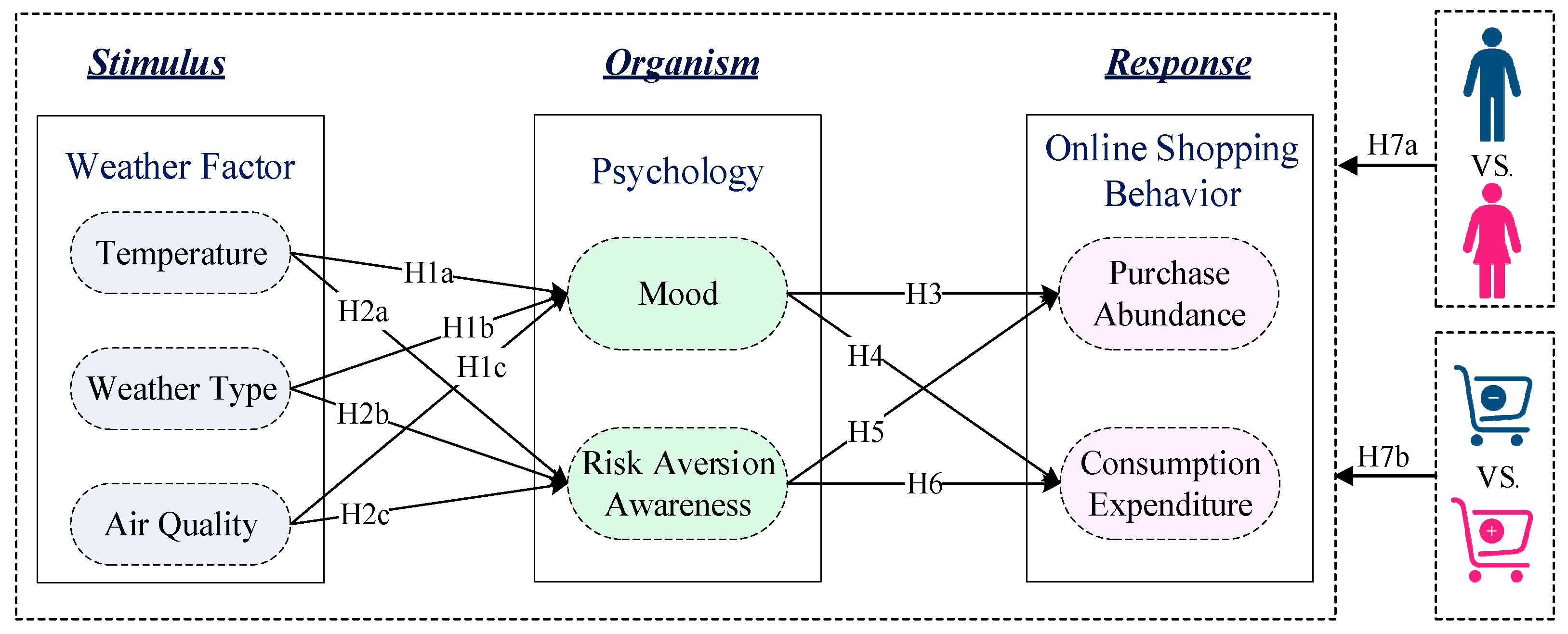
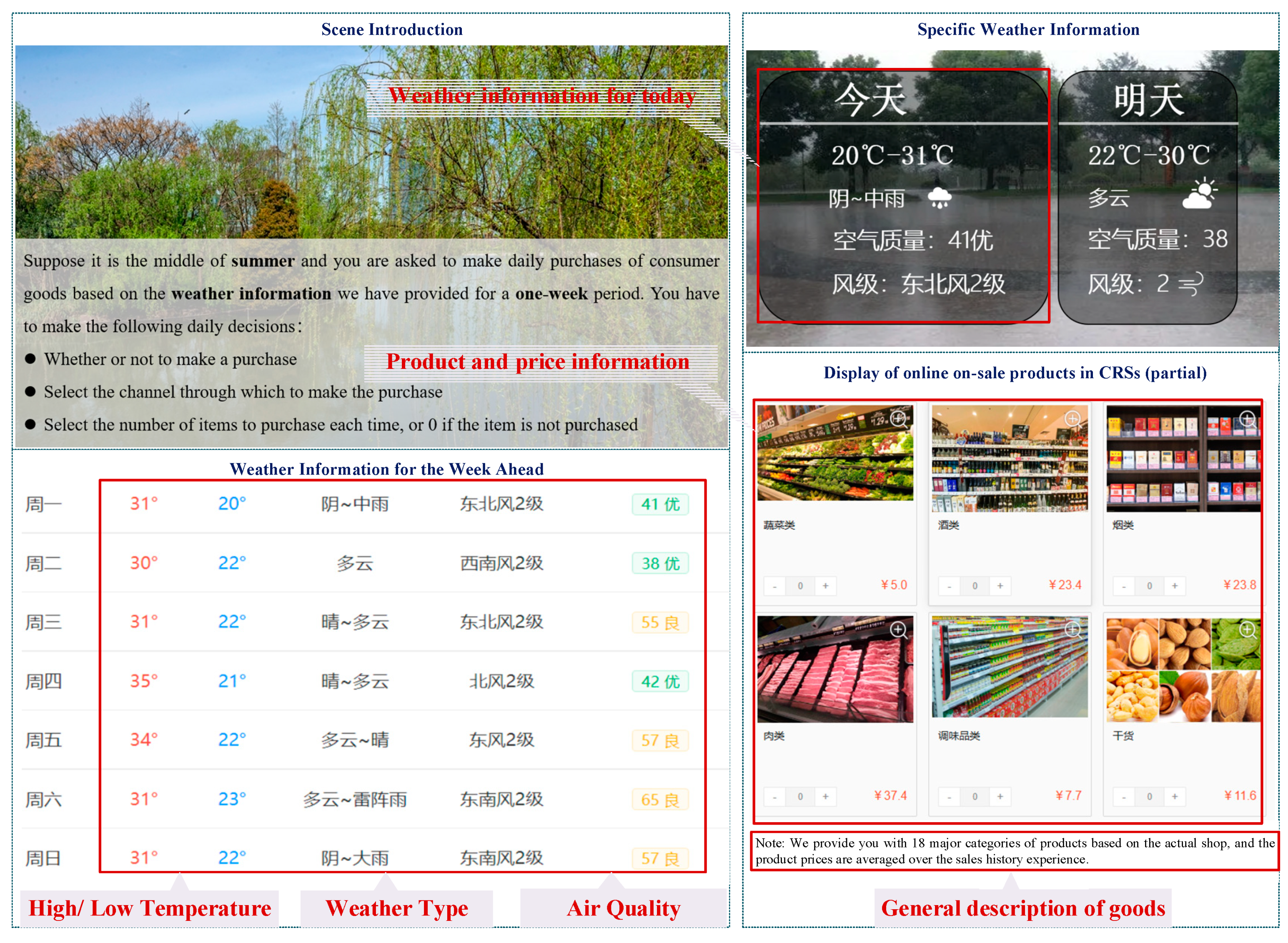
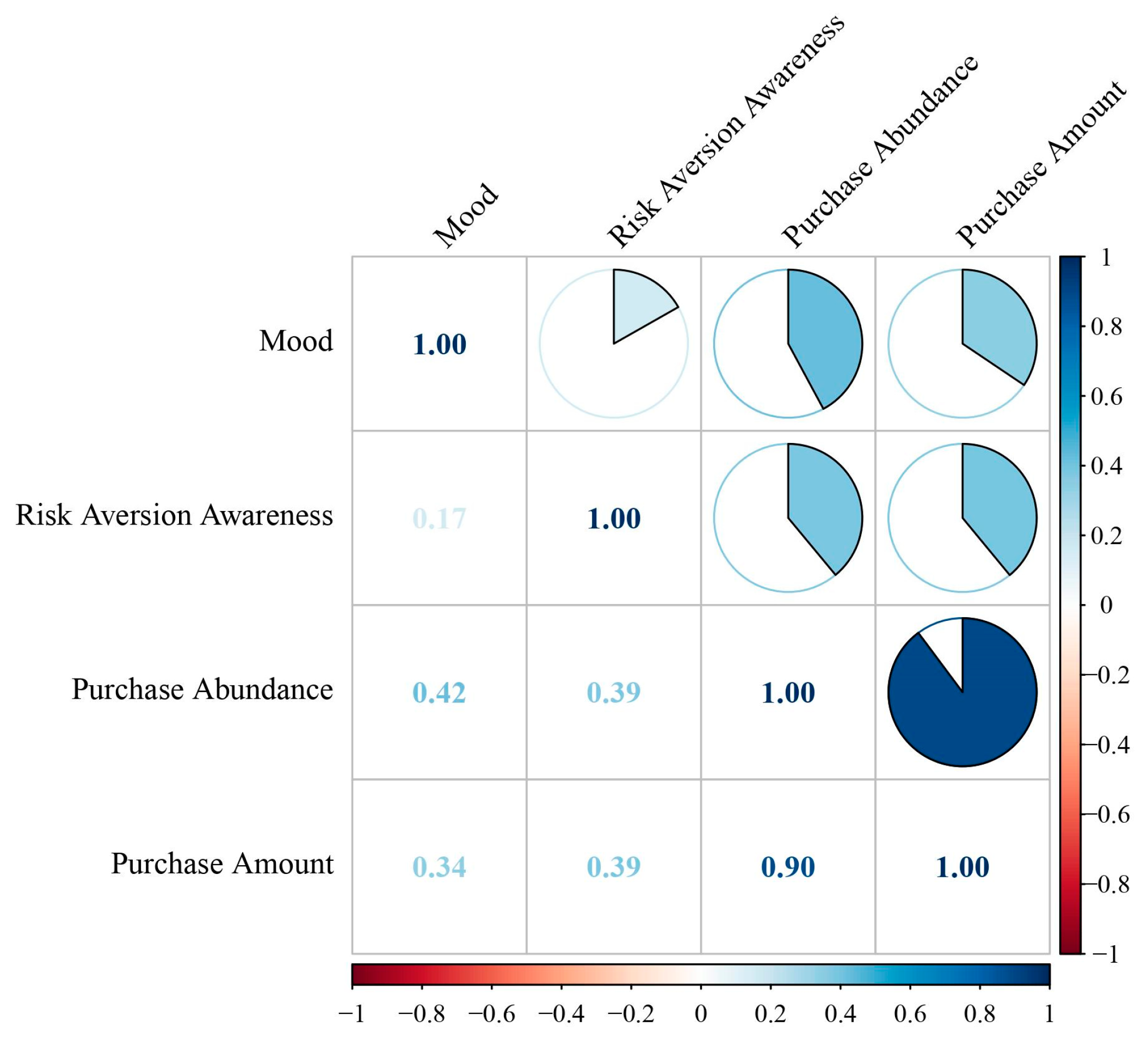
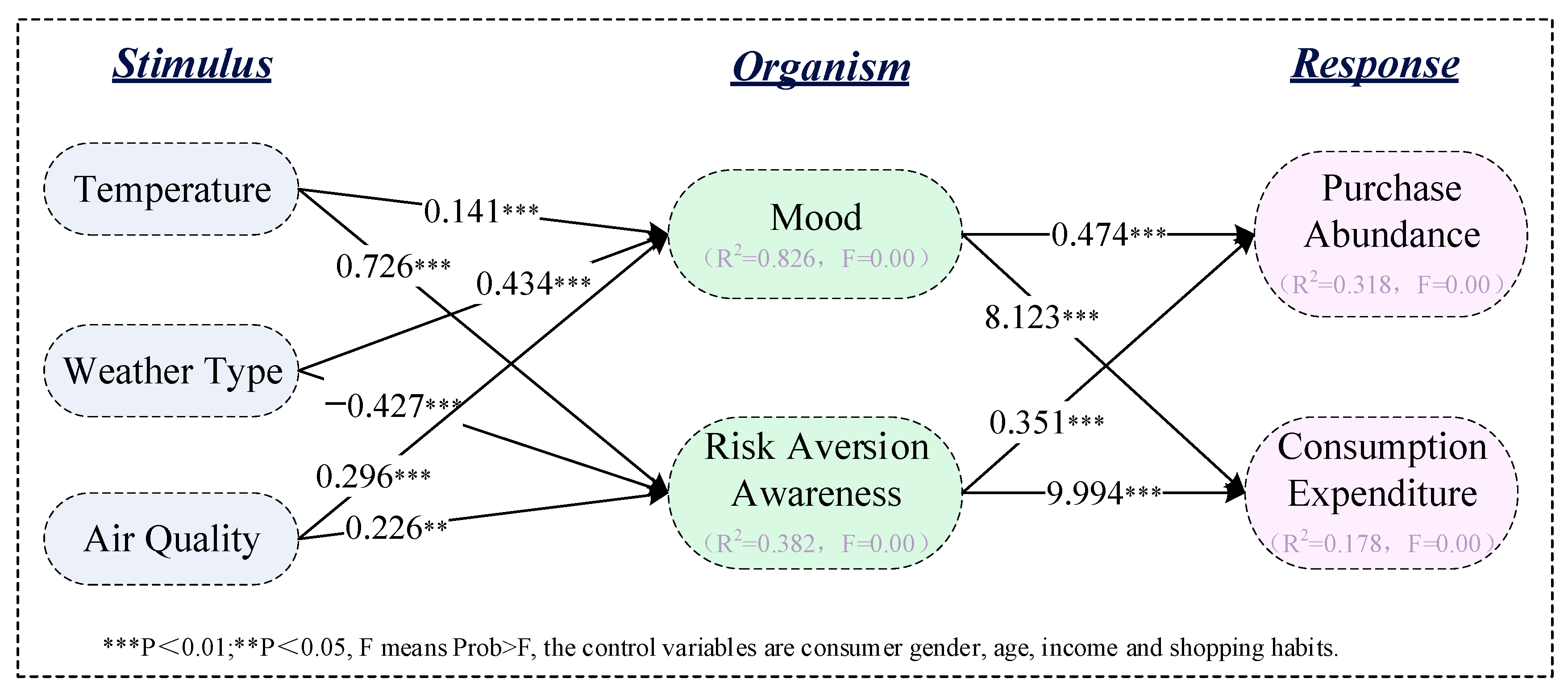
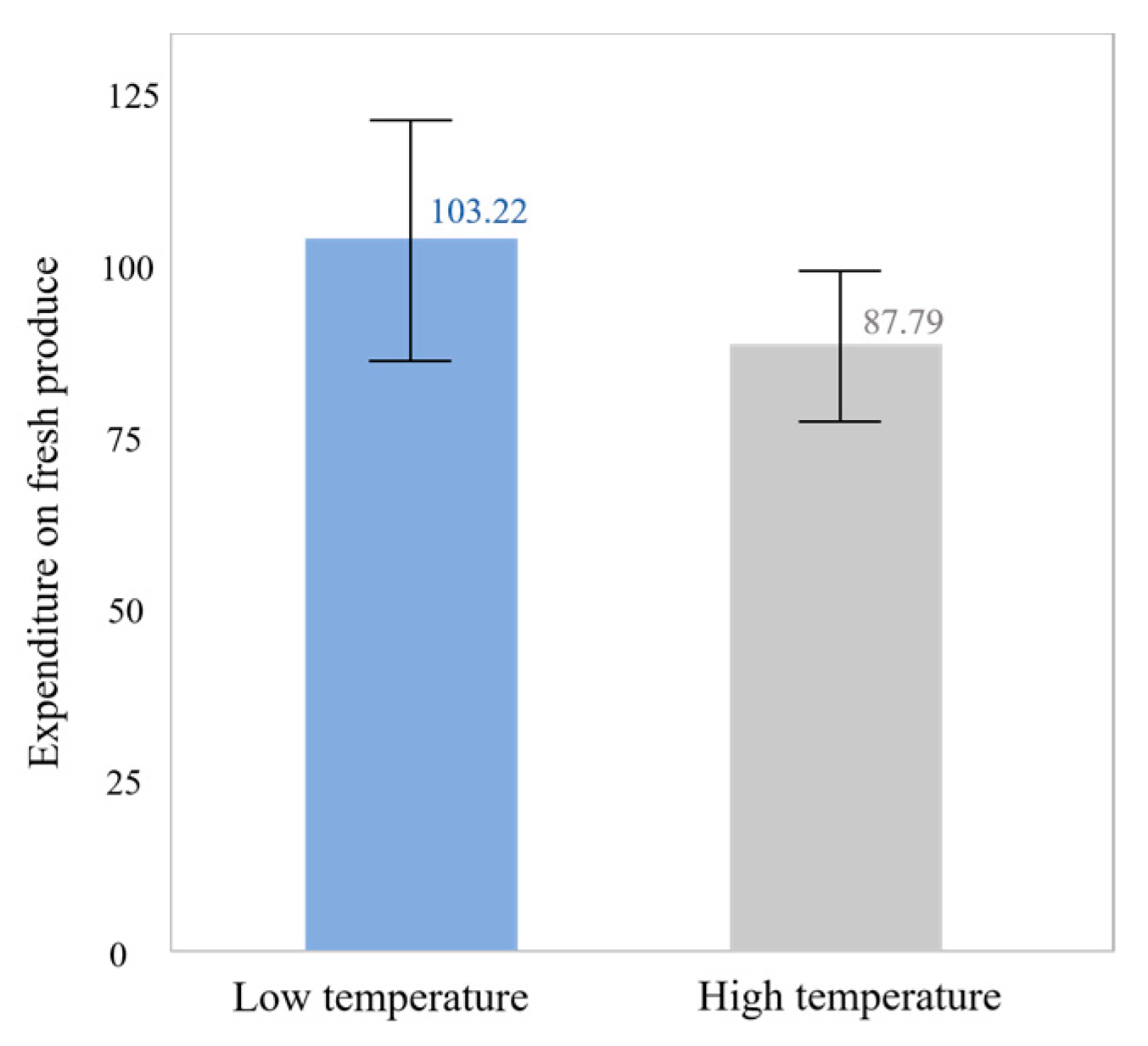
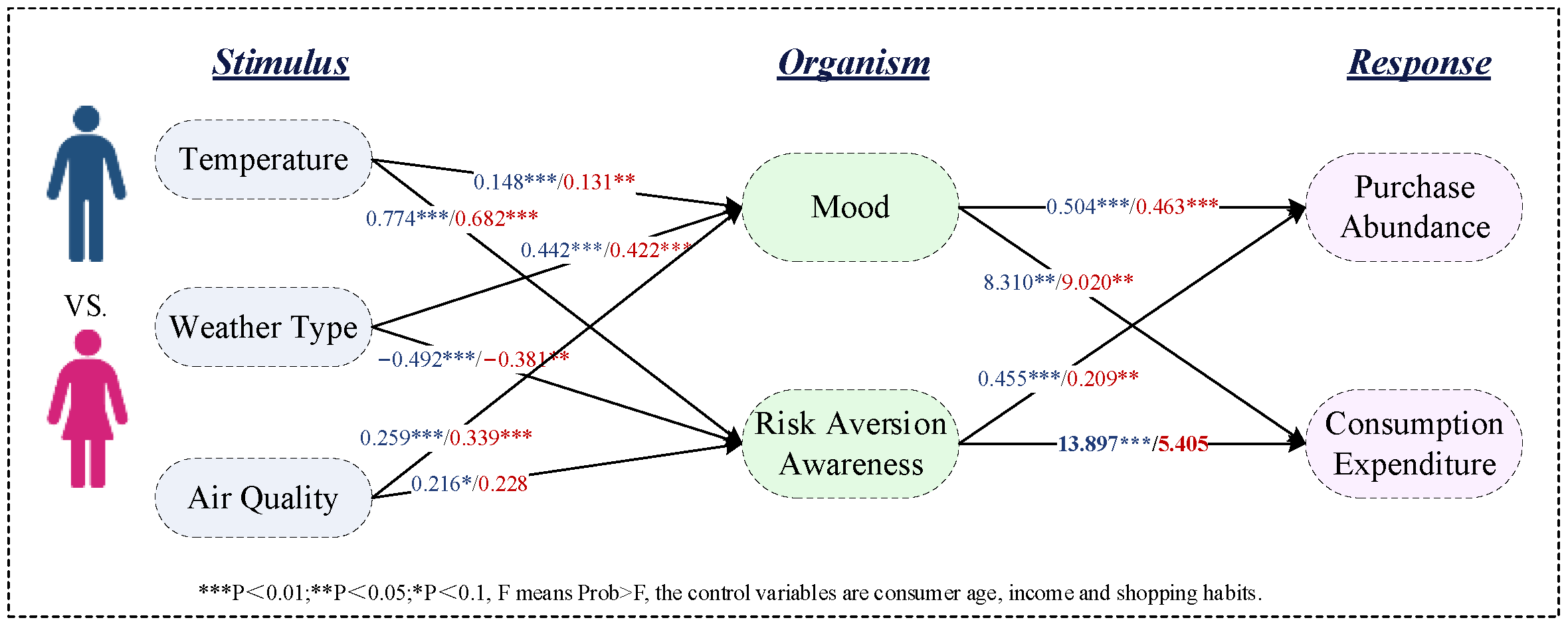
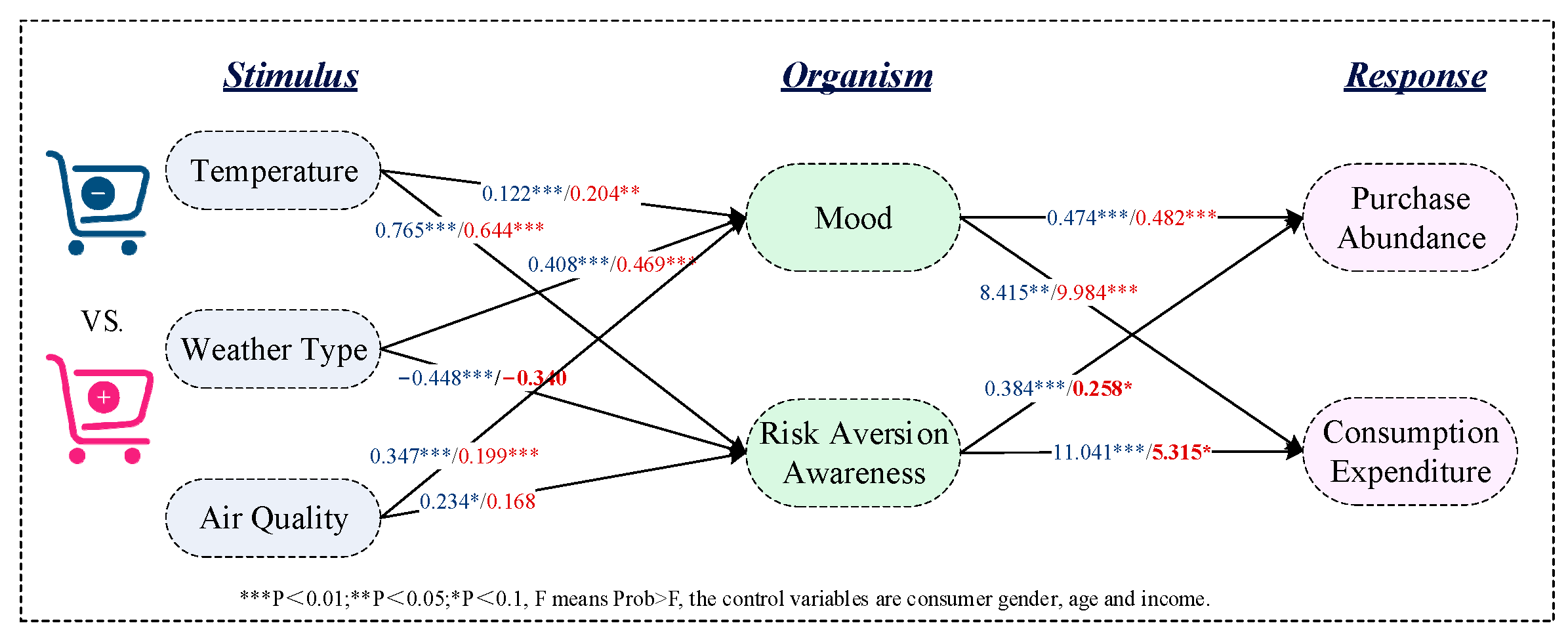
| Type | Title | References |
|---|---|---|
| S | T. According to the weather information we have provided, what do you think of the degree of today’s temperatures? | Measurement based on real conditions |
| W. According to the weather information we have provided, what do you think the weather type will be like today? (Judge by sunny, cloudy, rainy, or snowy.) | ||
| A. Based on the weather information we have provided, what do you think the air quality will be like today? | ||
| O | E1. Mood: happy (strongly agree to strongly disagree). | Babin and Darden [106] Shi, Wang, Qiao and Shang [107] Dang-Van et al. [109] |
| E2. Mood: relaxed (strongly agree to strongly disagree). | ||
| E3. Mood: excitedly (strongly agree to strongly disagree). | ||
| E4. Mood: lively (strongly agree to strongly disagree). | ||
| RAA1. I think that future purchases will be of poor quality and thus cause me financial loss (strongly agree to strongly disagree). | Murray and Schlacter [37], Derbaix [38]; Konuk [40] | |
| RAA2. In the long term, I think it’s important to stock up on functional items (strongly agree to strongly disagree). | Sweeney, Soutar and Johnson [39] Zielke, Komor and Schlößer [41] | |
| RAA3. The psychological and physical risks of going out are higher (strongly agree to strongly disagree). | Murray and Schlacter [37], Derbaix [38]; Zhao, Wang, Liu, and Jackson [42] | |
| R | PD. Online purchasing decisions for CRSs. | Calculate |
| Category | Classification | Percentage | Category | Classification | Percentage |
|---|---|---|---|---|---|
| Gender | Man | 122 (54.95%) | Age | Under 18 | 1 (0.45%) |
| Woman | 100 (45.05%) | 18~25 | 31 (13.96%) | ||
| Occupation | Students | 13 (5.86%) | 26~30 | 86 (38.74%) | |
| Production staff | 23 (10.36%) | 31~40 | 80 (36.04%) | ||
| Sales staff | 20 (9.01%) | 41~50 | 15 (6.76%) | ||
| Management staff | 46 (20.72%) | 51~60 | 8 (3.6%) | ||
| Administrative staff | 16 (7.21%) | 60 or more | 1 (0.45%) | ||
| Finance/Audit staff | 14 (6.31%) | Number of outgoing purchases (per week) | 0 | 1 (0.45%) | |
| Clerical staff | 17 (7.66%) | 1–3 | 149 (67.12%) | ||
| Technical/R&D staff | 30 (13.52%) | 4–6 | 64 (28.83%) | ||
| Others | 43 (19.37%) | 7 or more | 8 (3.6%) |
| Pathway | Direct/Indirect Effect | LLCI | ULCI | Mediating |
|---|---|---|---|---|
| Temperature → Mood → PA | 0.302 ***/0.225 *** | 0.104/0.084 | 0.500/0.331 | YES |
| Temperature → Mood → CE | 8.862 ***/2.797 *** | 2.282/−0.054 | 15.443/0.230 | No |
| Weather Type → Mood → PA | 0.484 ***/0.384 *** | 0.179/0.140 | 0.790/0.496 | YES |
| Weather Type → Mood → CE | 11.730 **/9.309 *** | 1.601/0.061 | 21.860/0.454 | YES |
| Air Quality → Mood → PA | 0.294 **/0.253 *** | 0.061/0.059 | 0.527/0.399 | YES |
| Air Quality → Mood → CE | 5.809/5.124 *** | −1.952/−0.018 | 13.570/0.322 | No |
| Temperature → Risk-Aversion Awareness → PA | 0.357 ***/0.171 *** | 0.206/0.066 | 0.508/0.258 | YES |
| Temperature → Risk-Aversion Awareness → CE | 6.573 **/5.122 *** | 1.571/0.050 | 11.503/0.263 | YES |
| Weather Type → Risk-Aversion Awareness → PA | 0.405 ***/0.141 *** | 0.264/0.051 | 0.546/0.188 | YES |
| Weather Type → Risk-Aversion Awareness → CE | 6.434 ***/3.947 *** | 1.695/0.043 | 11.173/0.177 | YES |
| Air Quality → Risk-Aversion Awareness → PA | 0.391 ***/0.156 *** | 0.251/0.065 | 0.532/0.216 | YES |
| Air Quality → Risk-Aversion Awareness → CE | 6.317 ***/4.616 *** | 1.616/0.049 | 111.019/0.219 | YES |
| Results and Conditions | Calibration Points | Descriptive Statistics | ||||||
|---|---|---|---|---|---|---|---|---|
| Fully Affiliated | Crossover Point | Completely Unaffiliated | Mean | Standard Deviation | Minimum | Maximum | ||
| Results | Risk-Aversion Awareness | −8.63 | −1.56 | 1.83 | −2.50 | 3.55 | −9.50 | 8.00 |
| Conditions | Temperature | −5.64 | 2.33 | 5.97 | 1.40 | 3.55 | −9.00 | 9.00 |
| Weather Type | −5.50 | 1.00 | 5.14 | 0.49 | 3.18 | −7.50 | 8.33 | |
| Air Quality | −7.00 | 0.54 | 4.90 | −0.12 | 3.39 | −9.00 | 8.00 | |
| Gender | 1.00 | 1.00 | 2.00 | 1.45 | 0.50 | 1.00 | 2.00 | |
| Age | 2.00 | 3.00 | 5.00 | 3.47 | 0.98 | 1.00 | 7.00 | |
| Habits | 2.00 | 2.00 | 3.00 | 2.36 | 0.56 | 1.00 | 4.00 | |
| Conditions | Consistency | Coverage |
|---|---|---|
| Temperature | 0.76 | 0.75 |
| Weather Type | 0.69 | 0.68 |
| Air Quality | 0.73 | 0.72 |
| Gender | 0.86 | 0.61 |
| Age | 0.75 | 0.62 |
| Habits | 0.81 | 0.62 |
| Combined Configurations | Path 1 | Path 2 | Path 3 |
|---|---|---|---|
| Temperature | ● | ● | ⊗ |
| Weather Type | ⊗ | ||
| Air Quality | ● | ⊗ | ● |
| Gender | • | • | • |
| Age | ⊗ | • | • |
| Habits | • | • | • |
| consistency | 0.952 | 0.886 | 0.855 |
| Raw coverage | 0.361 | 0.454 | 0.423 |
| Unique coverage | 0.055 | 0.020 | 0.019 |
| Solution consistency | 0.816 | ||
| Solution coverage | 0.663 | ||
Disclaimer/Publisher’s Note: The statements, opinions and data contained in all publications are solely those of the individual author(s) and contributor(s) and not of MDPI and/or the editor(s). MDPI and/or the editor(s) disclaim responsibility for any injury to people or property resulting from any ideas, methods, instructions or products referred to in the content. |
© 2024 by the authors. Licensee MDPI, Basel, Switzerland. This article is an open access article distributed under the terms and conditions of the Creative Commons Attribution (CC BY) license (https://creativecommons.org/licenses/by/4.0/).
Share and Cite
Liu, H.; Wang, J.; Zhang, R.; Liu, O. Does the Weather Still Affect Me When I Shop at Home? The Impact of Weather on Online Shopping Behavior. J. Theor. Appl. Electron. Commer. Res. 2024, 19, 2289-2311. https://doi.org/10.3390/jtaer19030111
Liu H, Wang J, Zhang R, Liu O. Does the Weather Still Affect Me When I Shop at Home? The Impact of Weather on Online Shopping Behavior. Journal of Theoretical and Applied Electronic Commerce Research. 2024; 19(3):2289-2311. https://doi.org/10.3390/jtaer19030111
Chicago/Turabian StyleLiu, Hongde, Jun Wang, Ruilin Zhang, and Ou Liu. 2024. "Does the Weather Still Affect Me When I Shop at Home? The Impact of Weather on Online Shopping Behavior" Journal of Theoretical and Applied Electronic Commerce Research 19, no. 3: 2289-2311. https://doi.org/10.3390/jtaer19030111






